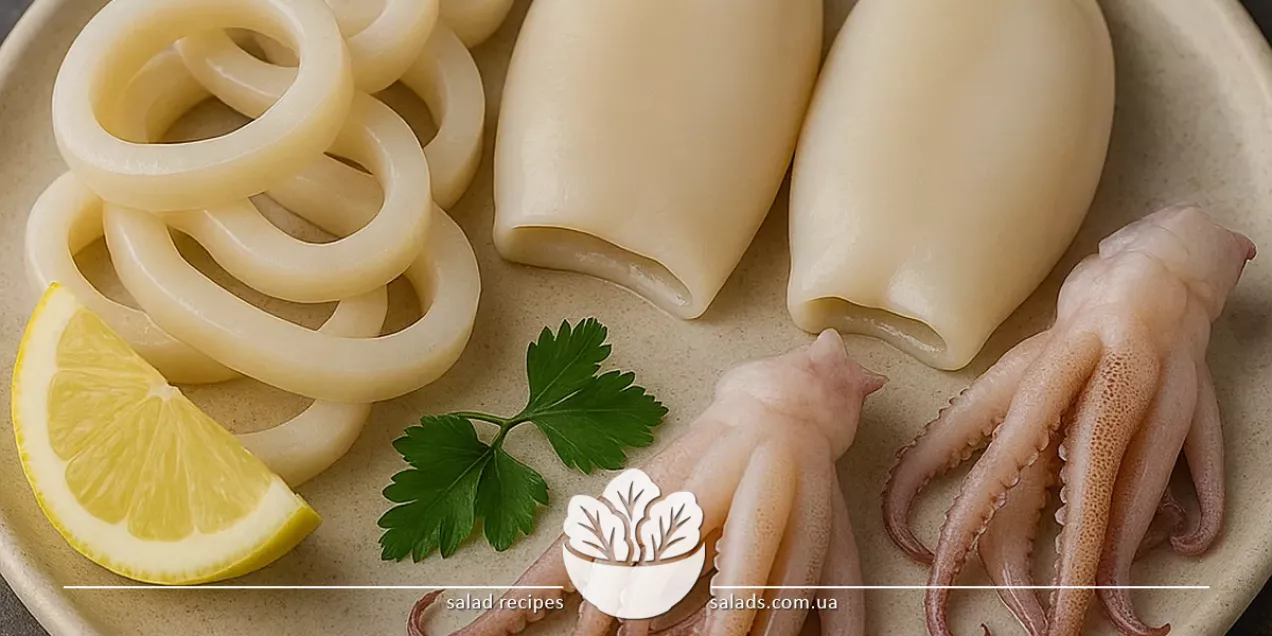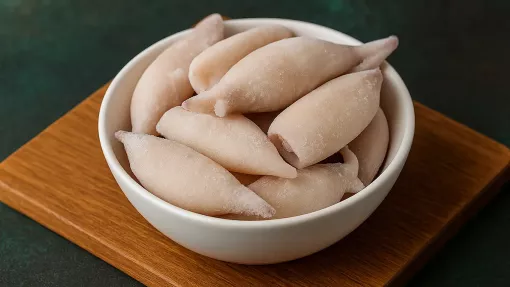Squid

Squid is a versatile and affordable type of seafood commonly used in the cuisines of many countries. It has a tender consistency, a light salty taste, and pairs well with vegetables, rice, pasta, legumes, and a variety of sauces. In stores, you can typically find cleaned or uncleaned whole squid, as well as frozen rings and tentacles. Squid can be grilled, pan-fried, boiled, stewed, baked, stuffed, or added to salads. Thanks to its quick cooking time, it’s convenient for daily meals. The product also has high nutritional value – it is a source of protein, trace elements, and healthy fats. If you're interested in other treasures from the sea, explore the seafood category.
Types of Squid
Common Varieties of Squid and Their Characteristics
Two main types of squid are most commonly available – Atlantic (European) and Pacific (Asian). Atlantic squid tend to be smaller in size, with tender meat and a lighter-colored body. They are often imported from Mediterranean countries, Iceland, or the northern Atlantic. These squid are ideal for boiling, frying, and baking, as their meat remains tender even after intensive heat treatment. Pacific squid are larger and have a firmer texture. They are widespread in Japan, China, Korea, Vietnam, and parts of South America. Their bodies are darker, and their flavor is richer. These squid are frequently used for grilling, stewing, or dishes with thick sauces that penetrate well into the meat fibers. Argentine squid are also popular – large and meaty, perfect for stuffing. There is also a separate niche of squid-based products – dried slices, marinated snacks, or jerky served with beer or in Asian-style salads. In different countries, local names are used – for example, ika in Japan or o-jin-o in Korea. Among seafood with similar culinary qualities, crab is worth mentioning – its meat is also delicate and flavorful but has a completely different fibrous texture and culinary use.
Meat Texture and Effect of Heat Treatment
Squid meat has a unique fibrous structure dominated by protein with minimal fat content. When raw, it is firm and slightly slippery, but after cooking it quickly changes texture – becoming soft or tough depending on the cooking method. The key rule: squid should either be cooked very quickly (up to 2 minutes) or stewed for a long time (from 30 minutes) over low heat. Short cooking preserves tenderness, while long cooking softens the fibers. Medium-length heat treatment, on the other hand, makes the meat rubbery. Squid readily absorbs the flavors of spices, marinades, and sauces, making it an ideal ingredient for dishes with pronounced flavor profiles. Before frying, it's often marinated in lemon juice, olive oil, garlic, and herbs. Boiled squid is usually used in salads or cold appetizers. Large bodies can be stuffed with vegetables, rice, cheese, or meat and baked in the oven. Squid tentacles are also used in cooking – either separately or together with the body. They have a firmer texture and sometimes a slight crunch after frying, which adds contrast to dishes. If you prefer meatier seafood, consider shrimp – they are easier to cook and consistently tender.
Nutritional Value and Health Benefits of Squid
Squid is not only tasty but also healthy. It contains complete protein that is easily absorbed by the body and has a low calorie content – about 90-100 kcal per 100 g. This makes it an excellent choice for those watching their weight or needing a protein boost for an active lifestyle. In addition, squid meat is rich in minerals such as iron, copper, phosphorus, zinc, and selenium. These trace elements help regulate metabolism, support the immune system, and improve skin and nail health. Another important feature is the high content of B vitamins, especially B12 and B6, which benefit the nervous system and blood formation. Omega-3 fatty acids, present in moderate amounts, promote heart health and reduce inflammation. Squid also contains taurine – an amino acid that supports vision, blood vessels, and metabolism. In everyday meals, squid can replace meat or fish, especially in recipes with stewed vegetables, grains, or legumes. If you’re looking for an alternative fish with similar nutritional value, consider herring – it’s also rich in omega-3, contains vitamins D and A, and is budget-friendly.
Serving Ideas and Ingredient Pairings
Squid is a universal ingredient that easily adapts to different culinary styles. In salads, it pairs well with eggs, cucumbers, bell peppers, green onions, or seaweed. Dressings can range from classic mayonnaise to lighter versions based on yogurt, sour cream, or olive oil with lemon. These salads are popular in colder months and are served as appetizers or main dishes. In hot meals, squid combines well with rice, noodles, pasta, or vegetable stews. It’s added to tomato or cream-based sauces, cooked with garlic and chili, baked with cheese, or stuffed with grains, vegetables, herbs, or carrots. In Mediterranean cuisine, squid is often grilled or baked with olive oil and spices. In Asian dishes, it’s used as a base for woks and soups – such as miso or tom yum. It’s important to maintain a balance of flavors: the delicate squid meat absorbs aromas well but can be overpowered if the dish is too rich. That’s why light side dishes are recommended – steamed vegetables, boiled rice, bulgur, couscous, or lentils. If you want to emphasize protein, a great alternative is tuna – it has a firmer texture, a rich flavor, and also pairs well with vegetables and sauces.
How to Choose and Store Squid
When choosing squid, pay attention to the appearance of the body. Fresh squid has firm, smooth skin in gray or purple shades, without discoloration or spots. Frozen squid should be dry, without surface ice or off smells. If you see frost or ice crystals, it may have been refrozen, which negatively affects quality. Cleaned squid – white in color – is also common in stores. It’s convenient to use but tends to lose juiciness faster during cooking. Note that cleaned squid is better for quick meals, while uncleaned ones are ideal for stewing, baking, or stuffing. Vacuum packaging should be airtight, without tears or swelling. If you're buying chilled squid, store it in the refrigerator at no more than +4°C and consume it within 1-2 days. Frozen squid can be stored for up to 3 months if kept at the right temperature. For convenience, divide the product into portions right away – this will simplify preparation and reduce the need for refreezing. After cooking, leftovers should be cooled and stored in an airtight container for no more than 24 hours. If you enjoy dishes made with protein-rich, healthy-fat fish, consider salmon – it’s an excellent alternative, especially for baking or steaming.
